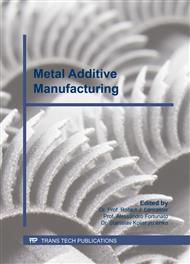[1]
E. Uhlmann, R. Kersting, T.B. Klein, M.F. Cruz, A.V. Borille, Additive manufacturing of titanium alloy for aircraft components Procedia CIRP, 35 (2015) 55-60.
DOI: 10.1016/j.procir.2015.08.061
Google Scholar
[2]
P. Singha, H. Pungotra, N.S. Kalsi, On the characteristics of titanium alloys for the aircraft applications, Materials Today: Proceedings, 4 (2017) 8971-8982.
DOI: 10.1016/j.matpr.2017.07.249
Google Scholar
[3]
B. Kianiana, S. Tavassoli, T.C. Larsson, The Role of Additive Manufacturing Technology in Job Creation: An Exploratory Case Study of Suppliers of Additive Manufacturing in Sweden, Procedia CIRP, 12th Global Conference on Sustainable Manufacturing, Emerging Potentials. 26 (2015).
DOI: 10.1016/j.procir.2014.07.109
Google Scholar
[4]
G.A. Ravi, C. Dance, S. Dilworth, M.A. Moataz, Fabrication of large Ti–6Al–4V structures by direct laser deposition, Journal of Alloys and Compounds, 629 (2015) 351-361.
DOI: 10.1016/j.jallcom.2014.12.234
Google Scholar
[5]
E. Rauch, M. Unterhofer, P. Dallasega, Industry sector analysis for the application of additive manufacturing in smart and distributed manufacturing systems Manufacturing Letters, (2017).
DOI: 10.1016/j.mfglet.2017.12.011
Google Scholar
[6]
H. Piili, A. Happonen, T. Väistö, V. Venkataramanan, J. Partanen, A. Salminena, Cost Estimation of Laser Additive Manufacturing of Stainless Steel, Physics Procedia. 78 (2015) 388-396.
DOI: 10.1016/j.phpro.2015.11.053
Google Scholar
[7]
D. Gu, New metallic materials development by laser additive manufacturing, Laser Surface Engineering, 2015, 163-180.
DOI: 10.1016/b978-1-78242-074-3.00007-6
Google Scholar
[8]
B. Dutta, S. Palaniswamy, J. Choi, L.J. Song, J. Mazumder, Additive manufacturing by direct metal deposition, Advanced Materials & Processing, 169 (2011) 33-36.
Google Scholar
[9]
S.M. Thompsona, L. Bianc, N. Shamsaeia, A. Yadollahi, An overview of Direct Laser Deposition for additive manufacturing; Part I: Transport phenomena, modeling and diagnostics, Additive Manufacturing, 8 (2015) 36-62.
DOI: 10.1016/j.addma.2015.07.001
Google Scholar
[10]
H.E. Cheikh, B. Courant, S. Branchu, X. Huang, J.-Y. Hascoet, R. Guille´n, Direct Laser Fabrication process with coaxial powder projection of 316L steel. Geometrical characteristics and microstructure characterization of wall structures Optics and Lasers in Engineering 50 (2012).
DOI: 10.1016/j.optlaseng.2012.07.002
Google Scholar
[11]
M. Attaran, The rise of 3-D printing: The advantages of additive manufacturing over traditional manufacturing, Business Horizons (2017).
DOI: 10.1016/j.bushor.2017.05.011
Google Scholar
[12]
T. DebRoy, H.L. Wei, J.S. Zuback, T.Mukherjee, J.W. Elmer, J.O. Milewski, A.M. Beese, A.Wilson-Heid, A.De, W.Zhang, Additive manufacturing of metallic components, Process, structure and properties. Progress in Materials Science, 92 (2018).
DOI: 10.1016/j.pmatsci.2017.10.001
Google Scholar
[13]
G.A. Turichin, A.Y. Travyanov, P.V. Petrovskiy, E.V. Zemlyakov, M. Kovac, S. Vondracek, A. Kondratiev, A.V. Khvan, V.V. Cheverikin, D.O. Ivanov, I.A. Bazhenova, A.T. Dinsdale, Prediction of solidification behaviour and microstructure of Ni based alloys obtained by casting and direct additive laser growth, Materials Science and Technology, 32(8) (2016).
DOI: 10.1179/1743284715y.0000000134
Google Scholar
[14]
J.S. Keist, T.A. Palmer, Role of geometry on properties of additively manufactured Ti-6Al-4V structures fabricated using laser based directed energy deposition, Materials and Design, 106(2016) 482-494.
DOI: 10.1016/j.matdes.2016.05.045
Google Scholar
[15]
X.G. Fan, H. Yang, P.F. Gao, S.L. Yan, Dependence of microstructure morphology on processing in subtransus isothermal local loading forming of TA15 titanium alloy, Materials Science and Engineering, A 546(2012) 46-52.
DOI: 10.1016/j.msea.2012.03.021
Google Scholar
[16]
Y.M. Ren, X. Lin, X. Fu, H. Tan, J. Chen, W.D. Huang, Microstructure and deformation behavior of Ti-6Al-4V alloy by high-power laser solid forming, Acta Material, 132 (2017) 82-95.
DOI: 10.1016/j.actamat.2017.04.026
Google Scholar
[17]
A.J. Sterling, B. Torries, N. Shamsaei, S.M. Thompson, D.W. Seely, Fatigue Behavior and Failure Mechanisms of Direct Laser Deposited Ti-6Al-4V, Materials Science and Engineering: A 655 (2016) 100-112.
DOI: 10.1016/j.msea.2015.12.026
Google Scholar
[18]
G.A. Turichin, V.V. Somonov, K.D. Babkin, E.V. Zemlyakov, O.G. Klimova, High-speed direct laser deposition: technology, equipment and materials, IOP Conference Series: Materials Science and Engineering Current Problems and Solutions, 125 (2016).
DOI: 10.1088/1757-899x/125/1/012009
Google Scholar
[19]
M.O. Sklyar, O.G. Klimova-Korsmik, V.V. Cheverikin, Formation Structure and Properties of Parts from Titanium Alloys Produced by Direct Laser Deposition, Solid State Phenomena, 265 (2017) 535-541.
DOI: 10.4028/www.scientific.net/ssp.265.535
Google Scholar
[20]
V. Matilainen, H. Piili, A. Salminena, T. Syvänenc, O. Nyrhilä, Characterization of Process Efficiency Improvement in Laser Additive Manufacturing, Physics Procedia, 56 (2014) 317-326.
DOI: 10.1016/j.phpro.2014.08.177
Google Scholar



